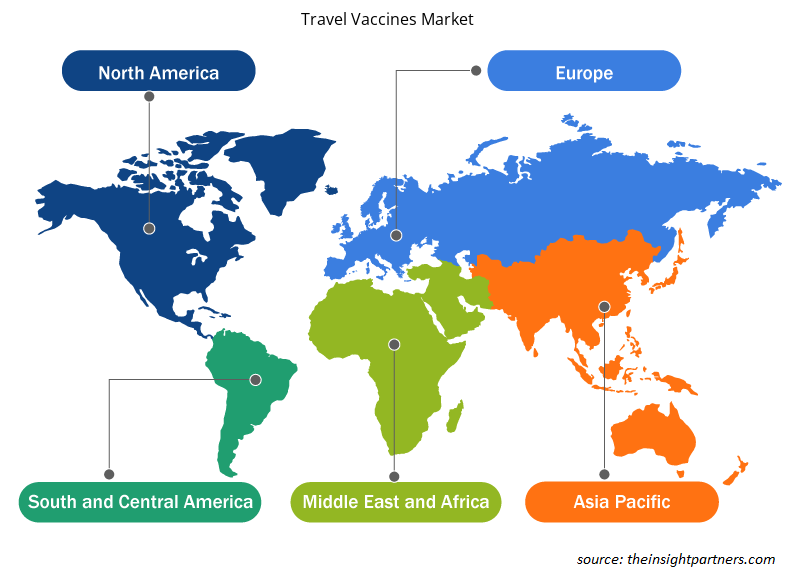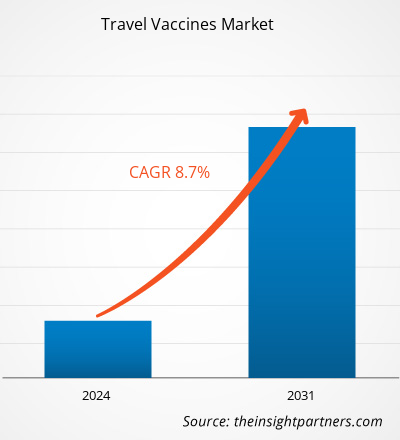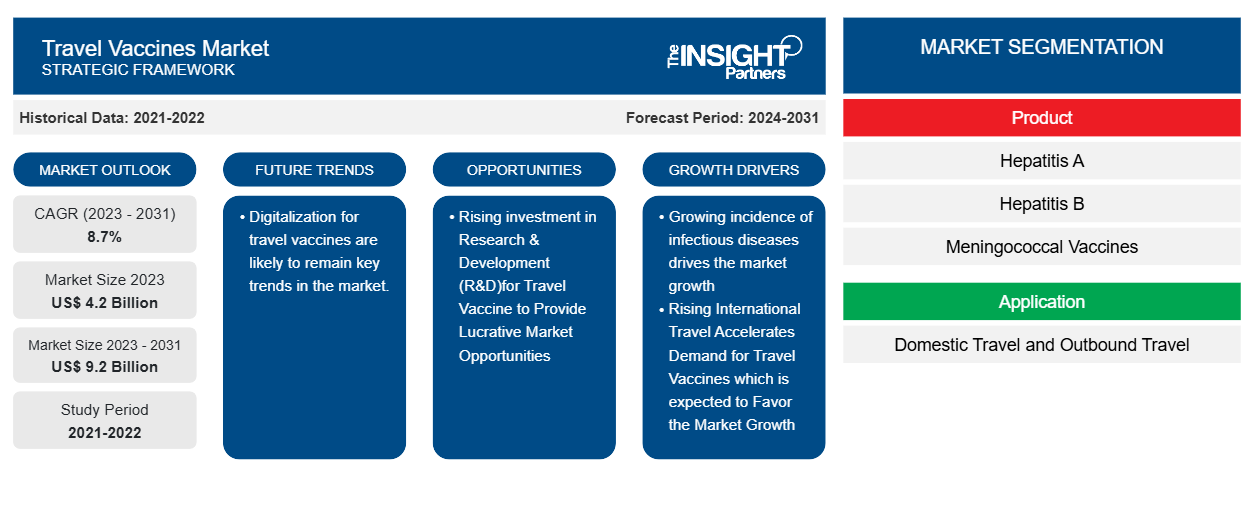Si prevede che il mercato dei vaccini da viaggio raggiungerà i 9,2 miliardi di dollari entro il 2031, rispetto ai 4,2 miliardi di dollari del 2023. Si prevede che il mercato registrerà un CAGR dell'8,7% nel periodo 2023-2031. È probabile che la digitalizzazione dei vaccini da viaggio rimanga una tendenza chiave nel mercato.
Analisi di mercato dei vaccini da viaggio
Le campagne di vaccinazione o i programmi di immunizzazione forniranno opportunità redditizie per la crescita del mercato dei vaccini da viaggio nei prossimi anni. La maggior parte dei paesi ha imposto la vaccinazione contro diverse malattie infettive. Tuttavia, c'è una mancanza di consapevolezza sulla vaccinazione nella maggior parte dei paesi a basso e medio reddito. Pertanto, diversi paesi in via di sviluppo conducono campagne di sensibilizzazione per le campagne di vaccinazione. Il Fondo delle Nazioni Unite per l'infanzia (UNICEF) è uno di questi esempi che ha istituito un progetto di vaccinazione per frenare il rotavirus, il pneumococco coniugato e il papilloma virus umano (HPV) in paesi come Samoa, Tonga, Tuvalu e Vanuatu. Il progetto è finanziato dalla Banca asiatica di sviluppo (ADB). L'ADB ha stanziato 29,7 milioni di dollari per il rafforzamento del sistema della copertura di nuovi vaccini nel progetto del Pacifico. I ministeri della salute del progetto hanno immunizzato 90.700 bambini contro la polmonite, quasi 71.600 bambini contro il rotavirus e 84.200 ragazze adolescenti contro le infezioni da HPV per i paesi in via di sviluppo. Tali fattori sopra menzionati agiscono come un fattore influente responsabile della considerevole crescita del mercato nel periodo 2021-2031. È probabile che la digitalizzazione per i vaccini da viaggio rimanga una tendenza chiave nel mercato.
Panoramica del mercato dei vaccini da viaggio
La crescente incidenza di malattie infettive guida la crescita del mercato. Ad esempio, la pandemia di COVID-19 è diventata una minaccia per la salute pubblica. Secondo il rapporto dell'Organizzazione mondiale della sanità (OMS), oltre 1,53 milioni di persone sono state colpite dalla pandemia e sono stati registrati quasi 3,2 milioni di decessi fino al 1° maggio 2021. Durante la pandemia sono state avviate diverse azioni di emergenza; tra cui, l'iniziativa COVAX è stata promulgata in modo aggressivo. I governi di ogni regione hanno imposto vaccini per le persone che viaggiano all'interno e all'esterno dei paesi. La pandemia di COVID-19 ha contribuito molto ai vaccini da viaggio e sta promuovendo la crescita del mercato.
Personalizza questo report in base alle tue esigenze
Riceverai la personalizzazione gratuita di qualsiasi report, comprese parti di questo report, o analisi a livello nazionale, pacchetto dati Excel, oltre a usufruire di grandi offerte e sconti per start-up e università
-
Scopri le principali tendenze di mercato in questo rapporto.Questo campione GRATUITO includerà analisi di dati che spaziano dalle tendenze di mercato alle stime e alle previsioni.
Driver e opportunità del mercato dei vaccini da viaggio
L'aumento dei viaggi internazionali accelera la domanda di vaccini da viaggio per favorire il mercato
I viaggiatori internazionali aumentano le possibilità di diffondere malattie rare. Pertanto, la vaccinazione prima del viaggio è fondamentale per garantire la salute pubblica globale e aiutare i viaggiatori a rimanere in salute durante e dopo i loro viaggi. Le vaccinazioni raccomandate per i viaggiatori variano in base a determinati fattori. I fattori hanno coinvolto l'età del viaggiatore, la storia delle vaccinazioni, le condizioni mediche esistenti, le destinazioni, le attività pianificate, la durata e la natura del viaggio e i requisiti legali per l'ingresso nei paesi di visita. Inoltre, i neonati che viaggiano per viaggi internazionali devono essere vaccinati principalmente contro difterite, tetano, pertosse acellulare, poliomielite inattivata e Haemophilus influenzae di tipo B, con o senza epatite B (DTaP-IPV-Hib o DTaP-HB-IPV-Hib) e vaccino pneumococcico coniugato. Ad esempio, la prima dose del vaccino contro morbillo-parotite-rosolia (MMR) deve essere somministrata a un'età più precoce del solito per i bambini che viaggiano fuori dal Canada. Pertanto, le crescenti malattie infettive accelerano la domanda di vaccini da viaggio, fungendo da principali motori della quota di mercato globale dei vaccini da viaggio.
Le attività di ricerca e sviluppo (R&S) saranno un'opportunità di mercato redditizia
- A dicembre 2021, Emergent BioSolutions Inc. ha annunciato il primo partecipante dosato nel suo studio di fase 1, EBS-UFV-001, che valuta la sicurezza, la tollerabilità e l'immunogenicità del candidato vaccino antinfluenzale universale sperimentale dell'azienda. La versione attuale del candidato vaccino antinfluenzale contiene più componenti destinati a indurre un'immunità ampia e sovrastagionale contro i virus dell'influenza A.
- A febbraio 2020, Abbott ha introdotto un nuovo vaccino quadrivalente inattivato per l'influenza . Il nuovo vaccino è il primo del suo genere a subunità che fornisce protezione contro quattro ceppi di virus, in India. È l'unico vaccino antinfluenzale quadrivalente da 0,5 ml in India che è stato approvato per l'uso nei bambini di età inferiore ai 3 anni.
Pertanto, si ritiene che l'aumento delle attività di ricerca e sviluppo avrà un impatto positivo sul mercato dei vaccini da viaggio, poiché offrirà l'opportunità di sviluppare prodotti avanzati.
Analisi della segmentazione del rapporto di mercato sui vaccini da viaggio
I segmenti chiave che hanno contribuito alla derivazione dell'analisi di mercato dei vaccini da viaggio sono tipologia, applicazione e utente finale.
- In base al prodotto, il mercato dei vaccini da viaggio è segmentato in epatite A, epatite B, vaccini meningococcici, DPT, febbre gialla, tifo, encefalite giapponese, morbillo, parotite e rosolia (MMR), rabbia, poliomielite, influenza, varicella e herpes zoster, colera e altri. Il segmento dell'epatite A ha detenuto la quota di mercato maggiore nel 2023.
- Per applicazione, il mercato è segmentato in viaggi nazionali e viaggi in uscita. Il segmento dei viaggi in uscita ha detenuto la quota maggiore del mercato nel 2023.
Analisi della quota di mercato dei vaccini da viaggio per area geografica
L'ambito geografico del rapporto sul mercato dei vaccini da viaggio è suddiviso principalmente in cinque regioni: Nord America, Asia Pacifico, Europa, Medio Oriente e Africa, Sud e Centro America.
Il Nord America ha dominato il mercato. Nella regione del Nord America, gli Stati Uniti rappresentano la quota maggiore del mercato dei vaccini da viaggio. La presenza dei principali produttori nella regione e le loro innovative offerte di prodotti sono i fattori che contribuiscono al predominio del mercato. Si prevede che l'Asia Pacifica crescerà con il CAGR più elevato nei prossimi anni.
Approfondimenti regionali sul mercato dei vaccini da viaggio
Le tendenze regionali e i fattori che influenzano il mercato dei vaccini da viaggio durante il periodo di previsione sono stati ampiamente spiegati dagli analisti di Insight Partners. Questa sezione discute anche i segmenti e la geografia del mercato dei vaccini da viaggio in Nord America, Europa, Asia Pacifico, Medio Oriente e Africa e America meridionale e centrale.

- Ottieni i dati specifici regionali per il mercato dei vaccini da viaggio
Ambito del rapporto sul mercato dei vaccini da viaggio
| Attributo del report | Dettagli |
|---|---|
| Dimensioni del mercato nel 2023 | 4,2 miliardi di dollari USA |
| Dimensioni del mercato entro il 2031 | 9,2 miliardi di dollari USA |
| CAGR globale (2023-2031) | 8,7% |
| Dati storici | 2021-2022 |
| Periodo di previsione | 2024-2031 |
| Segmenti coperti |
Per Prodotto
|
| Regioni e Paesi coperti |
America del Nord
|
| Leader di mercato e profili aziendali chiave |
|
Densità degli attori del mercato dei vaccini da viaggio: comprendere il suo impatto sulle dinamiche aziendali
Il mercato dei vaccini da viaggio sta crescendo rapidamente, spinto dalla crescente domanda degli utenti finali dovuta a fattori quali l'evoluzione delle preferenze dei consumatori, i progressi tecnologici e una maggiore consapevolezza dei benefici del prodotto. Con l'aumento della domanda, le aziende stanno ampliando le loro offerte, innovando per soddisfare le esigenze dei consumatori e capitalizzando sulle tendenze emergenti, il che alimenta ulteriormente la crescita del mercato.
La densità degli operatori di mercato si riferisce alla distribuzione di aziende o società che operano in un particolare mercato o settore. Indica quanti concorrenti (operatori di mercato) sono presenti in un dato spazio di mercato in relazione alle sue dimensioni o al valore di mercato totale.
Le principali aziende che operano nel mercato dei vaccini da viaggio sono:
- GSK
- Merck & Co., Inc
- Sanofi
- Nuova impresa
- Pfizer
- Tecnologie Dynavax
Disclaimer : le aziende elencate sopra non sono classificate secondo un ordine particolare.

- Ottieni una panoramica dei principali attori del mercato dei vaccini da viaggio
Notizie e sviluppi recenti sul mercato dei vaccini da viaggio
Il mercato dei vaccini da viaggio viene valutato raccogliendo dati qualitativi e quantitativi post-ricerca primaria e secondaria, che includono importanti pubblicazioni aziendali, dati di associazioni e database. Di seguito sono elencati alcuni degli sviluppi nel mercato dei vaccini da viaggio:
- Bavarian Nordic A/S ha annunciato una partnership con Emergent Biosolutions Inc. per l'acquisizione di due vaccini da viaggio commercializzati "Vivotif" per la prevenzione della febbre tifoide e "Vaxchora" contro il colera, nonché del candidato vaccino di fase 3 per prevenire il virus Chikungunya. L'acquisizione mira non solo ad ampliare il portafoglio di prodotti commerciali e ad assumere una posizione di leadership nei vaccini da viaggio, ma anche a rafforzare la posizione dell'azienda nella pipeline attraverso promettenti vaccini in fase avanzata. (Fonte: Bavarian Nordic A/S, sito web, febbraio 2023).
Copertura e risultati del rapporto sul mercato dei vaccini da viaggio
Il rapporto “Dimensioni e previsioni del mercato dei vaccini da viaggio (2021-2031)” fornisce un’analisi dettagliata del mercato che copre le seguenti aree:
- Dimensioni e previsioni del mercato dei vaccini da viaggio a livello globale, regionale e nazionale per tutti i principali segmenti di mercato coperti dall'ambito
- Tendenze del mercato dei vaccini da viaggio e dinamiche di mercato come fattori trainanti, limitazioni e opportunità chiave
- Analisi dettagliata delle cinque forze PEST/Porter e SWOT
- Analisi di mercato dei vaccini da viaggio che copre le principali tendenze del mercato, il quadro globale e regionale, i principali attori, le normative e i recenti sviluppi del mercato
- Analisi del panorama industriale e della concorrenza che copre la concentrazione del mercato, l'analisi della mappa di calore, i principali attori e gli sviluppi recenti per il mercato dei vaccini da viaggio
- Profili aziendali dettagliati
- Analisi storica (2 anni), anno base, previsione (7 anni) con CAGR
- Analisi PEST e SWOT
- Valore/volume delle dimensioni del mercato - Globale, Regionale, Nazionale
- Industria e panorama competitivo
- Set di dati Excel
Report recenti
Testimonianze
Motivo dell'acquisto
- Processo decisionale informato
- Comprensione delle dinamiche di mercato
- Analisi competitiva
- Analisi dei clienti
- Previsioni di mercato
- Mitigazione del rischio
- Pianificazione strategica
- Giustificazione degli investimenti
- Identificazione dei mercati emergenti
- Miglioramento delle strategie di marketing
- Aumento dell'efficienza operativa
- Allineamento alle tendenze normative























 Ottieni un campione gratuito per - Mercato dei vaccini da viaggio
Ottieni un campione gratuito per - Mercato dei vaccini da viaggio